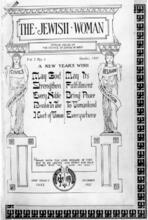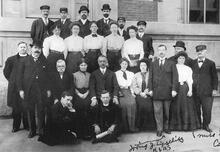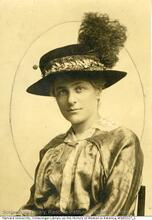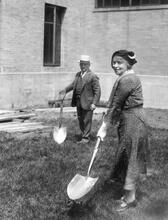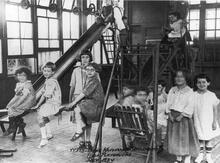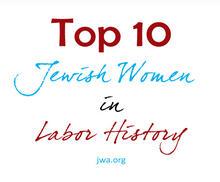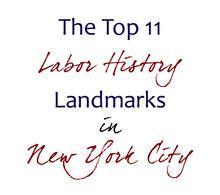Sisterhoods of Personal Service in the United States
Drawing on the traditional role of women as caretakers in American synagogues, Sisterhoods of Personal Service were among several types of Jewish social welfare organizations formed in the late nineteenth century. They attracted the talents and interests of thousands of middle-class Jewish women to run the sisterhoods’ religious schools and settlement houses, which hosted child care, courses for adults in English and American citizenship, libraries, employment offices, and more. Formed in response to the major influx of Eastern European immigrants, the Sisterhoods’ efforts were occasionally seen as patronizing and unwelcome, emphasizing a schism between the working-class or poor immigrants and the wealthier sisterhood women. Nevertheless, Sisterhoods assisted hundreds of families, and their legacy of service lives on in modern-day synagogue sisterhoods.
Introduction
In his 1892 history of Congregation Rodeph Sholom of New York City, Aaron Wise lavishes praise upon the women of the synagogue’s sisterhood. Founded two years earlier, the sisterhood had, in Wise’s words, “achieved the greatest measure of success through the combined and individual efforts … in behalf of all the needy and distressed” of the city. The “indefatigable zeal and ardor they have displayed in the pursuit of their ‘task of love’” earned the women of Rodeph Sholom a place of pride in the synagogue’s history.
Thousands of middle-class Jewish women throughout the United States took up this “task of love” in the late decades of the nineteenth century, forming Sisterhoods of Personal Service at synagogues across the country. Gustav Gottheil, the rabbi of Temple Emanu-El in New York City, organized the first sisterhood, primarily to aid the masses of Jewish immigrants pouring into the city. By 1905, Hannah B. Einstein could report in the Jewish Encyclopedia that most of the large congregations in New York City boasted Sisterhoods of Personal Service, and that a Federation of Sisterhoods had been established there in 1896 to coordinate sisterhood work with that of the United Hebrew Charities (UHC). The UHC assigned each sisterhood to a district of Manhattan, spreading their work throughout the city.
Activities of the Sisterhoods
The Sisterhoods of Personal Service constituted a significant unit within the constellation of Jewish social welfare organizations, personally assisting a considerable number of immigrants through a variety of financial, vocational, educational, and social programs. Though each sisterhood carried out its responsibilities in its own fashion, many opened offices in the districts they were assigned to serve, and some established their own settlement houses, modeled on such institutions as Jane Addams’s Hull House and Lillian Wald’s Henry Street Settlement. Sisterhood settlement houses offered an array of services: kindergartens and nurseries for the children of working mothers; clubs for children; recreation activities; adult classes in English, American citizenship, and, for women, in housekeeping, cooking, and sewing; libraries; employment bureaus; and opportunities for both children and adults to spend summer vacations outside of the city.
In addition, many sisterhoods operated religious schools, both to teach Jewish children the principles of Judaism and to combat the influence of the Christian missionaries flooding immigrant areas seeking converts. The sisterhood of New York’s Shearith Israel (the Spanish and Portuguese synagogue) even organized a synagogue, B’rith Shalom, in its neighborhood house at 86 Orchard Street, a move which the sisterhood claimed made it “the only settlement house in the country in which a fully organized synagogue, holding the old traditional services on Sabbath, the festivals and the holy days, is an integral part of the work.”
Forging a New Path, Facing Pushback
The Sisterhoods of Personal Service drew on an existing tradition of women’s benevolence in American synagogues. Modeling themselves on the numerous middle-class Protestant women’s organizations formed during the nineteenth century, and inspired by the notion that women were responsible for the moral upkeep of society, antebellum Jewish women had formed ladies’ auxiliaries, ladies’ fuel committees, and ladies’ benevolent or aid societies, offering financial assistance to both their synagogues and the Jewish poor.
Only with the sudden influx of Eastern European immigrants in the 1880s and 1890s, however, did these organizations become fully devoted to what the Shearith Israel Sisterhood called “philanthropic and educational work by personal service and other practicable methods,” focusing their attentions almost entirely on serving society rather than the synagogue. The difference between the new Sisterhoods of Personal Service and previous women’s organizations, Einstein noted in 1899, was that rather than being merely a “subscriber” to charitable organizations, each sisterhood member “was to devote a certain fixed portion of her time to a definite task and attend it herself; the chief object being the bringing together of the well-to-do and the poor—the ‘haves and the have nots’—by means of friendly visiting.”
Such attention often met with reluctance or even outright hostility from those the sisterhoods hoped to aid. The significant class schisms between the working-class or poor immigrants, on the one hand, and the middle- and even upper-class sisterhood women, on the other, did not escape either group, and the line was often crossed between helping the poor to help themselves and offering charity to and trying to Americanize the “teeming masses.” Some immigrant leaders exhorted their peers to become self-sufficient and to reject what they perceived as the condescending charity offered by sisterhood women.
Despite the hostility of some of those whom they attempted to assist, the Sisterhoods of Personal Service achieved much during their three decades of existence. Their religious schools and English classes were often filled to capacity, the waiting lists for their programs and services were generally long, and thousands of immigrants received financial, emotional, educational, or spiritual assistance from sisterhood women. B’nai Jeshurun’s historian records that in 1907 alone, over 500 families received relief from the synagogue’s sisterhood, and sisterhood members personally visited almost half of those families.
Demise of the Sisterhoods
Though it is difficult to pinpoint the terminus of the period of the Sisterhoods of Personal Service, a significant event took place in 1918 in New York City, when the UHC and the city’s sisterhoods amicably severed their relationship. Both sides cited the need for greater control over social welfare in the city, including the standardization of practice and the creation of a professional class of social workers. While some sisterhoods continued to operate through an affiliation with the Federation for the Support of Jewish Philanthropic Societies in New York City, this step toward the professionalization of social work left many sisterhoods without the credentials to continue their work.
Also influential in the demise of the sisterhoods were the sharp curtailment of immigration in the interwar period, the increasing financial solvency of the generation of immigrants who had once relied on the sisterhoods for assistance, and the competing financial and social demands of the two world wars. At the very latest, the Sisterhoods of Personal Service existed until the 1930s. These organizations did not simply disappear, however. Most of them evolved into modern-day synagogue sisterhoods, turning their attentions inward to the synagogue rather than outward to society.
Einstein, Hannah. “The Federation of Sisterhoods.” Twenty-Fifth Annual Report of the United Hebrew Charities (1899), and “Sisterhoods of Personal Service.” JE (1905).
Federation of Jewish Women’s Organizations. Papers. American Jewish Historical Society, Waltham, Mass..
Fifty Years of Social Service: The History of the United Hebrew Charities of the City of New York (1926).
Goldstein, Israel. A Century of Judaism in New York: B’nai Jeshurun, 1825–1925 (1930).
Joselit, Jenna Weissman. “The Special Sphere of the Middle-Class American Jewish Woman: The Synagogue Sisterhood, 1890–1940.” In The American Synagogue: A Sanctuary Transformed, edited by Jack Wertheimer (1987).
Menken, Alice Davis. Annual Report, 1916–1917. Sisterhood Papers. Archives of Congregation Shearith Israel, NYC.
Pool, David de Sola, and Tamar de Sola Pool. An Old Faith in the New World: Portrait of Shearith Israel, 1654–1954 (1955).
Wise, Aaron. The History of Congregation Rodeph Sholom of New York (1892).


